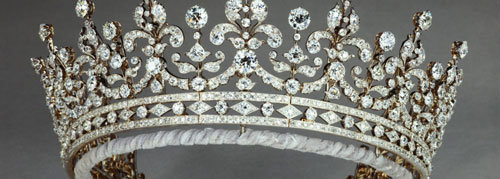By
Reuters
Reuters
Published
Jun 30, 2012
Jun 30, 2012
Queen's 10,000 diamonds on display in London
By
Reuters
Reuters
Published
Jun 30, 2012
Jun 30, 2012
More than 10,000 diamonds go on show at London's Buckingham Palace this week to mark Queen Elizabeth's 60th year on the throne, in a dazzling display of gems gathered over the centuries as objects of beauty and symbols of power.
 Photo: The Royal Collection |
The exhibition, which runs from June 30 to July 8 and then from July 31 to Oct. 7, was designed to coincide with the queen's diamond jubilee this year, and features jewels she wears regularly at official functions in Britain and abroad.
"The aim of the exhibition is to show how rulers have used diamonds as visible signs of wealth and power," said curator Caroline de Guitaut, who described the crowns, tiaras, rings, earrings, swords and snuff box on display as "priceless."
De Guitaut said the 86-year-old monarch was consulted on what would be used for the exhibition, housed in a darkened room inside Buckingham Palace and accessed via gilded, colonnaded corridors lined with royal portraits going back generations.
"We have tried to showcase some of the most important diamonds in royal possession."
The first item on show in a brightly lit glass case is Queen Victoria's small diamond crown which, despite its size, features more than 1,100 diamonds.
After her husband Prince Albert's death in 1861, the only other British monarch to have marked a diamond jubilee wore only mourning clothes, meaning that colourless stones such as clear diamonds were an ideal adornment.
Victoria was regularly pictured wearing it, including in her official diamond jubilee portrait.
Perhaps the most impressive display, however, is that containing seven of the nine major stones cut from the Cullinan Diamond, the largest ever found.
SCEPTRE, CROWN AND MORE
The gemstone was discovered in South Africa in 1905 and was so large that a clerk working at the mine initially threw it away, assuming it was a worthless crystal.
Eventually, though, the stone weighing 3,106 carats in its rough state was presented to King Edward VII who decided to have it cut and polished.
It produced nine principal stones and 96 small brilliant diamonds. The two main gems, the largest colourless and flawless cut diamonds in the world, were set in the Sovereign's Sceptre and Imperial State Crown.
Like many of the important diamonds in the exhibition, Cullinan III and IV were used in a variety of settings over time but today form a brooch worn by Queen Elizabeth at a service of thanksgiving at St. Paul's Cathedral earlier this month.
Cullinan V is in a brooch, Cullinan VII hangs as a pendant from an emerald necklace, Cullinan VI and VIII are also in a brooch and Cullinan IX, the smallest of the nine main stones at 4.4 carats, is set into a platinum ring.
Underlining how diamonds were used as gifts of diplomacy as well as objects of desire, Queen Victoria's fringe brooch includes stones presented to her by the Sultan of Turkey as a token of thanks for Britain's support in the Crimean War.
Victoria appears not to have appreciated the sultan's tastes, and had the jewels reset.
The Jaipur Sword and Scabbard were presented to King Edward VII for his coronation in 1902 by the Maharajah of Jaipur, and have been set with 719 diamonds weighing 2,000 carats in total.
More recently, Queen Elizabeth II was gifted the Williamson Diamond in 1947 by Canadian geologist and royalist John Thorburn Williamson, and it is considered the finest pink diamond ever discovered.
From its original uncut 54.5 carats it was cut into a 23.6-carat round brilliant stone and now sits in the centre of a flower-shaped brooch by Cartier.
While De Guitaut said she could not even guess the value of the diamonds on display, a pink diamond of similar size without royal provenance, fetched $46 million at an auction in Switzerland in 2010.
Of all the royals represented in the exhibition, Queen Mary's name came up most often.
Queen Elizabeth's grandmother clearly had a passion for jewellery, and among her acquisitions was a snuff box made originally for Frederick II of Prussia and his court.
The box is covered with nearly 3,000 diamonds, including many on the bottom which would normally be invisible, and came to England after the Russian Revolution. There it was sold twice before being purchased by Mary in 1932.
© Thomson Reuters 2024 All rights reserved.

























